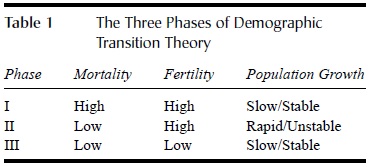Prior to the 20th century, many social scientists believed that at some point the carrying capacity of the earth would be outstripped by the needs of the rapidly growing human population. However, during the 20th century, data became available that led social scientists to abandon the idea that the human population would continue to grow in an unsustainable manner. This change came about with the realization that, from the late 18th through the 19th century, numerous European countries experienced dramatic demographic transitions that were eventually mimicked by countries in other parts of the world. These demographic transitions might ultimately stabilize the world population.
Demographic transition theory posits that populations ultimately stabilize by way of a three-phase process (see Table 1). Characterizing the first of these phases are high rates of mortality offset by high rates of fertility to create a balanced mortality-fertility regime with slow population growth. Characterizing the second phase is rapid population growth brought about by continued high levels of fertility and declining levels of mortality. Historically, dramatic population growth has most often resulted from lower death rates, not higher birth rates. Characterizing the third and final stage of demographic transition are low levels of fertility and low levels of mortality.

While general agreement exists that preceding declines in fertility are declines in mortality, no consensus exists as to the cause of fertility decline. Some argue that high levels of fertility reflected strategies of familial and self-preservation in the face of high mortality levels at all stages in the life course. Others focus on structural changes in societies, namely industrialization and urbanization, as the main causes of fertility decline. In agricultural societies children were, among other things, economic assets—crucial to family and household economics. Young children could provide substantial manual labor, infant and child care, and elder care. To the extent that this is true of preindustrial societies, it is not surprising to find high fertility levels among them. In the urban-industrial context, however, children become economic liabilities because economically productive activities are generally removed from the household where children can easily contribute. Modern child labor laws and compulsory schooling have further undermined the ability of children to contribute to household economics. Still others attribute fertility decline to cultural changes in societies, namely, modernization and secularization, which are not necessarily tied to the structural changes described earlier.
Irrespective of the causes, much of the world is moving into the third stage of the demographic transition. In the space of two generations, Mexico and other less-developed countries cut their fertility rates in half—from more than five children per woman to less than three. All of this has led population experts to less frequently ask, “What must be done about the population explosion?” and more often to ask, “How do societies work when people stop replacing themselves?”
Bibliography:
- Chesnais, Jean-Claude. 1992. The Demographic Transition: Stages, Patterns, and Economic Implications. New York: Oxford University Press.
- Morgan, S. Philip. 2003. “Low Fertility in the Twenty-first Century.” Demography 40:589-603.
This example Demographic Transition Theory Essay is published for educational and informational purposes only. If you need a custom essay or research paper on this topic please use our writing services. EssayEmpire.com offers reliable custom essay writing services that can help you to receive high grades and impress your professors with the quality of each essay or research paper you hand in.




